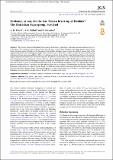Evidence, or not, for late Tonian break-up of Rodinia? The Dalradian Supergroup, Scotland
Date
03/03/2023Metadata
Show full item recordAbstract
The Tonian-Cambrian Dalradian Supergroup, Scotland, is a siliciclastic-carbonate succession as much as 10 km thick. The consensus view is that its lower part, the mid-late Tonian Grampian and Appin groups, formed in rift basins: deep-marine turbidites of the former infilled rift depocentres and shallow-marine strata of the latter marked basin-bounding palaeohighs. That scenario is used as evidence to infer onset of break-up of Rodinia between Laurentia and Baltica. However, deformation during mid-Ordovician Caledonian orogenesis obscured original depositional frameworks. Reconstructing those frameworks (and hypothesised rift basins) relied on trace- and major-element geochemistry of carbonate rocks to assign units to either the Grampian or Appin groups, i.e. to rift depocentres or basin-bounding palaeohighs, respectively. We report new carbon and oxygen isotope and geochemical data to create a revised stratigraphic framework for the Grampian and Appin groups. Our findings show that previous geochemical-based correlations are unreliable and that there is no evidence for palaeohighs or rift basins. Instead, the Grampian-Appin groups are a deeper- to a shallower-marine (flysch to molasse) succession formed in response to the mid-Tonian Knoydartian Orogeny. From a Scottish perspective, evidence for break-up of Rodinia is recorded higher in the Dalradian succession during deposition of the early Cryogenian Argyll Group.
Citation
Prave , T , Fallick , A E & Kirsimäe , K 2023 , ' Evidence, or not, for late Tonian break-up of Rodinia? The Dalradian Supergroup, Scotland ' , Journal of the Geological Society , vol. 180 , no. 2 , jgs2022-134 . https://doi.org/10.1144/jgs2022-134
Publication
Journal of the Geological Society
Status
Peer reviewed
ISSN
0016-7649Type
Journal article
Description
Funding: Fieldwork was funded by A.R.P. Analyses funded by University of Tartu.Collections
Items in the St Andrews Research Repository are protected by copyright, with all rights reserved, unless otherwise indicated.

